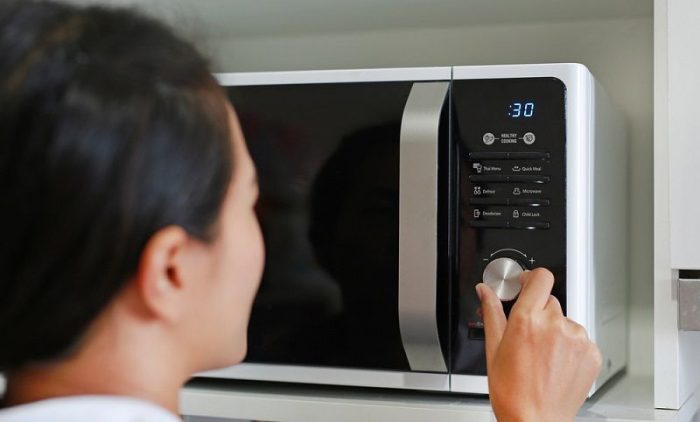If you are aware of the negative effects and radiation that come from microwaves, you must also be aware that you must protect yourself and your closest ones as much as possible from it. As this type of radiation can be found everywhere around us today, it can be incredibly challenging to find the right way that would protect you from microwaves efficiently.
Therefore, as this concern has been increasing among thousands of people across the globe, I decided to write this article and share with you what material stops microwaves so that this radiation stays as further away from you as possible.

What Material Stops Microwaves?
Regarding what material stops microwaves, there is not only one answer. But, although few materials can protect you from this type of radiation, the most efficient one is definitely metal.
More specifically, the best metal materials for blocking dangerous microwaves are metal foam, metal mesh, or sheet metal. The most important thing regarding these three types of constructions is that the metal must be magnetic or conductive. The best example of magnetic or conductive metals is copper and aluminum, which are proven to have the biggest power against microwaves.
Additionally, another essential thing you need to know is that if you decide to use a metal mesh, you must ensure that the holes in the mesh are smaller than the wavelength of the microwaves. The reason behind this is that if the holes in the metal mesh are bigger than the wavelength, the metal mesh will simply let the microwaves through it, which is not what you are looking for.
So, to sum up, once you have detected microwave radiation, the material that will help you stop it is conductive metal. This type of metal is certainly your best bet. And if you want to read something more about it, you can do so in continuation.
What is a conductive metal?
After learning what material stops microwaves, I would like to dig a little deeper into the definition of conductive metal and why this is the best choice when it comes to protection from microwave radiation.
To put it simply, an electrical conductor is a material that conducts electricity. Additionally, the ability itself to conduct electricity is called electrical conductivity, and it differs from metal to metal.
The characteristics that make an electrical conductor good are low resistivity and high conductivity. Some of the most used and prominent electrical conductors that come with these characteristics are copper, aluminum, silver, gold, and even human skin and water.
That said, if you want to protect yourself from microwave radiation, you can use any of the conductive metals with high electrical conductivity. This process is called shielding and can be done in various ways, as you can read below.

Shielding
Although there are many ways you can do shielding, the three most efficient methods are aluminum foil shielding and copper shielding.
Aluminum foil shielding
Out of these two ways, aluminum foil shielding is the most straightforward and cheapest one. Thanks to its versatility, you can use aluminum foil in various ways and still be protected from the negative effects of microwave radiation in your home. You can use aluminum foil in the shape of self-adhesive tape, rolls, or even attached to insulating foam boards.
Another way you can find aluminum foil is laminated with brown or plastic paper. Still, I do not recommend this type as laminated aluminum foil as it does not have the potency of regular foil.
Is there a difference between thicker and thinner aluminum foil?
The thickness of the metal, or, in this case, of the aluminum foil, does not play any role in the level of protection. The super-thin aluminum foil will have the same effect as a thick piece of metal, so you do not need to worry about that.
The only thing you must pay attention to is that, on the material, there are no holes larger than the shortest wavelength of the microwaves trying to enter.
Aluminum screening
Even though any type of aluminum foil will do the job, aluminum screening might be the most effective. This screening can effectively block microwaves much better than simple aluminum foil.
How to test whether aluminum foil is stopping and blocking microwaves?
The best and most accurate way to test whether an aluminum foil or screening works is by utilizing an accurate EMF meter. With this type of meter, besides seeing the radiation, you will get lots of essential information regarding radiation in your home. With the help of all this personalized information, you can improve and stop microwaves even more efficiently.
Copper shielding
Are you still wondering what material stops microwaves? The second conductive metal that stops microwaves is copper. This metal is significantly more effective in protecting you from microwaves compared to aluminum, but at the same time, it is much more expensive.
The reason why copper is a better protector than aluminum is that this metal conducts electricity much better, resulting in higher shielding from microwaves.
Copper, just like aluminum foil, comes and can be used in various shapes and forms, such as foils, fabrics, paints, meshes, and sheets. In contrast to aluminum, which is most widely used in the shape of foil, copper is usually used in the form of meshes and fabrics.
Copper fabrics and meshes
If you want to invest in the ultimate microwave protection material, purchasing copper fabrics or meshes can be the right choice. These meshes and fabrics are highly versatile and can be utilized in numerous ways.
If you are looking for a more flexible choice, you will have to use copper fabric, but if you need stiffer material, copper mesh it is. The fabrics and mashes also come with additional materials, such as silver and aluminum in the copper meshes, and nylon, cotton, or polyester, in the copper fabrics.
Utilization of copper fabrics and meshes
Thanks to the wide palette of uses the copper fabrics and copper meshes come with, you can get creative and put them on the walls, put them as curtains on the windows, turn them into canopies around the bed, place them on ventilation holes, cover the ceilings, etc.
